A few weeks ago my son and I decided to create a circular route around the centre of Edinburgh that took in as many as possible of the ‘essential sights’ This week we came up with a plan to create a second walking tour but this time one that explored the New Town and covered the major Art galleries of the city. This route will take you through some stunning parts of our beautiful city.
The tour starts and ends on The Mound but mostly will avoid the areas covered in our previous tour, this means you should be able to do both over a weekend without retracing your ground too much. So lets begin.
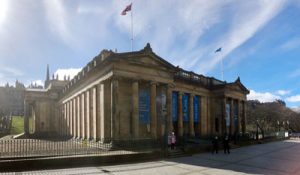 Begin at The Mound on Princes Street. The Mound splits Princes Street Gardens in two and runs North to South. To the East of the road there are two large Neoclassical buildings The one at the rear is the Scottish National Gallery and the one at the front on Princes St is the Royal Scottish Academy. The Scottish National Gallery holds the permanent collection of Scottish and European Art from the Renaissance up to the early 20th Century. Here you will find much of the art you would expect in a major city gallery with excellent works by the likes of Botticelli, Degas, El Greco, Cezanne and Monet. The gallery has had a number of major refurbishment including a new basement area a few years ago.
Begin at The Mound on Princes Street. The Mound splits Princes Street Gardens in two and runs North to South. To the East of the road there are two large Neoclassical buildings The one at the rear is the Scottish National Gallery and the one at the front on Princes St is the Royal Scottish Academy. The Scottish National Gallery holds the permanent collection of Scottish and European Art from the Renaissance up to the early 20th Century. Here you will find much of the art you would expect in a major city gallery with excellent works by the likes of Botticelli, Degas, El Greco, Cezanne and Monet. The gallery has had a number of major refurbishment including a new basement area a few years ago.
The Royal Scottish Academy (RSA) was formerly the Scottish Royal Institute building and is now home of the Academy. Here you will normally find a rolling exhibition of Scottish contemporary art by both the Academy and the Society of Scottish Artists. If you are lucky you will find work by established and emerging artists in Scotland as well as work from Students of the major Art colleges.
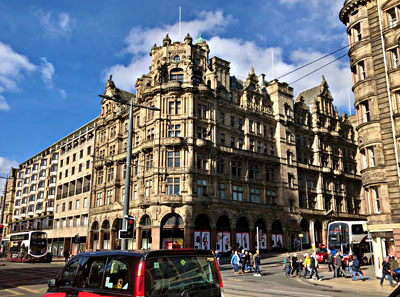
After taking in these galleries, and maybe taking a moment to take in any street theatre going on in the public space outside cross the square heading east and head towards the Scott Monument (the very tall pointed monument in the east part of Princes Street Gardens). I covered the monument in the last tour so for now we will go past this and out the other side of the gardens at Waverly Bridge. Turn immediately left onto Princes street and then left again. As you draw level with the Scott Monument from the other side again take a look at the large ornate building on the corner across from you. This is Jenners Department Store, possibly the most ‘over the top’ shop front you will ever see. Jenners was the oldest independent department store in Scotland until it was sold to House of Fraser in 2005. The original building that stood here was destroyed by fire in 1892 and the present building was completed in 1895. Scholars of classical architecture will spot that every conceivable type of Greek column is featured in the building including some magnificent caryatids (Grecian female figures). Apparently these are designed to portray how women are the ‘support’ of the establishment. Feel free to explore inside too if you have time (and deep pockets).
From Jenners take the street that runs north, Away from the Scott Monument (St David’s Street) up to St Andrews Square. The Square was one of the first parts of the New Town to be constructed from James Craig’s plan and the buildings that surround the square were once the most prestigious in Scotland, housing most of Scotland’s major banking headquarters at one time. It is impossible to miss the monstrous column in the centre of the square. The figure on top is not Nelson or even Trajan but Henry Dundas, Viscount Melville. despite the grandeur of the monument Dundas was not a figure to be celebrated. A Scottish advocate and Tory politician Dundas was a strong opponent of the abolition of slavery and was impeached from his position as Secretary of War over the misappropriation of public funds. Maybe one day the city might see fit to replace the man once referred to as ‘The Uncrowned King of Scotland’ with someone more befitting the position. For now though cross the square through the gardens to the opposite corner.
from here head north down North St Andrews St with the Harvey Nichols store store on your right. After a short distance you will some to a busy street (Queen Street), As you approach the street take note on the building on the left corner and look for the statues built into the red sandstone facade. We are now at the Scottish National Portrait Gallery.
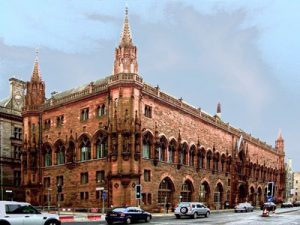
The Scottish National Portrait Gallery was built some time after the National Portrait Gallery was founded in London but it was the first building in the world to be purpose built as a portrait gallery. Here you will find a wide collection of portraits and sculptures of famous Scots, to compensate for the lack of likenesses of some of the more ancient figures from Scotland’s history many appear as sculptures on the outside of the building. The main hall has an absolutely magnificent frieze called The Parade of Scottish History by William Hole. This Arts and Crafts style frieze runs around the main space and is best viewed from the first floor. The parade begins with Adam (or perhaps a generic Neolithic hunter) and ends with the historian Thomas Carlyle and features pretty much every notable Scot (and a few non Scots such as Hadrian and Columba) in between.
The gallery also has a pretty good cafe so this might be a good opportunity to take a little break.
After leaving the Gallery cross over Queen St and turn left. The occasional gap in the high hedge on your right will give you brief views into Queen Street Gardens. These are private gardens for New Town residents and one of a few such private spaces in the city. People who live in the Streets nearby can apply to rent keys for the gardens for a token sum. It’s been said that a young Robert Louis Stevenson played here as a child and that the boating pond and small island gave him the inspiration for his book Treasure Island. Sadly for you though as a visitor there will be no visits to Treasure Island and this is one treasure you can only view over a spiked railing. continue over the crossing to the next break in the gardens at “Queen St Gardens West”. Turn right here and head downhill. If you made the correct turn a large Church should be ahead of you at the bottom of this road; St Stephen’s Church.
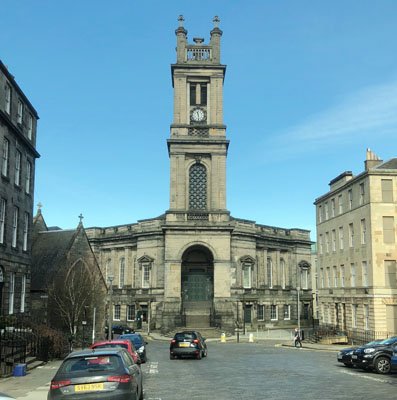
As you progress down this street this is a good chance to get a flavour of the design of the New Town; wide cobbled streets with light sandstone buildings of varied heights give the area an open and light feel, very different from the narrow winds and closes of the old town. Just before you get to the church look for a narrow cobbled lane on the left (Circus Lane). This well photographed little street is adorably picturesque with its fashionable mews flats. Take a little wander up here but come back and take the next left when you reach the front of the church onto St Stephens St.
St Stephen’s Street curves gently left and features an array of interesting little shops and a few pretty decent pubs for anyone needing a quick top up. Just before you get to the end of St Stephen’s Street look out for a small road on the right and the entrance to Stockbridge Market. Sadly this grand entrance is a little misleading as most of the original market space has been built over but the narrow lane does sometimes have little stalls some times during the year, cut through here and onto the street on the other side. Cross over and turn left. Just past the bus stop you will come to a bridge over the Water of Leith who will be your companion the next leg of your trip.
You are now in Stockbridge proper. A small village that was swallowed up as the city expanded north. The sandstone bridge over the water replacing the wooden or ‘Stocc’ bridge that gave the village its name. Take time to admire the view from the bridge and cross over to the other side. This area can be quite busy with traffic but make your way to the opposite corner of the bridge and find the cobbled street that runs upstream on the right bank called Dean Terrace. This very pretty Georgian street is a far more attractive way to follow the riverside than the rather ugly modern buildings on the left bank. Carry on for about 200m till you come to another bridge, cross over this and again catch a fantastic view of the river upstream. In the centre of this bridge a set of steps will take you down onto the path below, take this and carry on upstream along any of the available paths. after another 100m or so you will come so a round classical structure with a statue in the centre, St Bernard’s Well.
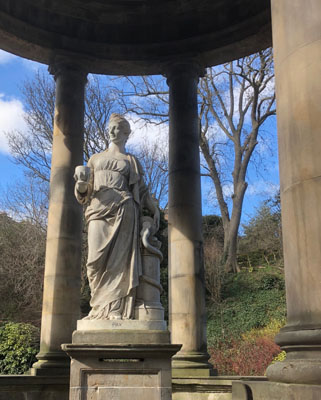
St Bernard’s well marks the spot of a mineral water spring which was said to have great healing properties. The monument sits above a pump room for the well. The statue is if Hygeia the Greek goddess of health. A couple of notable people have owned this well including the painter Henry Raeburn and the great grandfather of the music hall entertainer Harry Lauder. Carry on past the well and follow the water of Leith upstream.
Very soon you will begin to notice buildings very high up on your left and through the trees ahead spot that you are about to pass under as very high stone bridge. This is the Dean Bridge, designed by Thomas Telford and completed in 1833 the bridge spans over 400 feet and rises 106 feet over the Dean Gorge. The bridge transformed access to this part of the city when it opened and now carries one of the main arterial routes out. Fans of Peter May’s Lewis trilogy will recall the bridge is featured in one of the stories. As you pass under the bridge look back to see the soaring spires of the Holy Trinity Episcopal Church to the left of the bridge. The church was converted to an electricity transformer station in the 1950s but kept its original character, transmitting the power of electricity rather than the power of prayer.
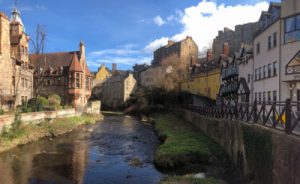 Back down at the humble river level you will spot a weir in the river and a display of mill wheels on a circular area ahead. This area was once an important industrial area for the city with several mills using the power of the river. The first mention of a mill here was in 1145 when King David granted one of the mills to Holyrood Abbey. You are now passing into Dean village an area of exceptional beauty within the city. Dean village is one of the few examples of a medieval village within a city in the world and though fashionable now was still a slum area of great poverty right up until the 1960s. Follow the path past the mill buildings and up onto the bridge where a small cobbled street crosses. Keep the bridge and river on your right and cross the road into a narrow cobbled street with half timbered Elizabethan buildings ahead of you. The stunning Well Court stands on the opposite bank. This impressive collection of red and grey buildings with red pitched roofs and turrets was built as housing for mill workers that featured well layed out flats with communal areas and a recreation hall for use by residents. As the lane you are on bends left take the small footbridge on the right over the river. The view downstream from here is one of the most photographed in the city and worth taking time to contemplate the marvellous scene and take lots of photos. Cross the bridge then double back underneath it to keep following the river upstream on the right hand bank. A set of metal steps will take you up past another weir and further along the Water of Leith path. The path meanders along by the river bank for a little while, bending to the left almost back on itself, keep going until you reach a brown sign pointing up some earthwork steps to Dean Gallery (at the time of writing this part of the path was closed due to repairs being carried out). When you reach road level look for a stone doorway in the high wall just ahead on your right signed as Scottish National Gallery of Modern Art. go through the arch to Dean Gallery one of two buildings that houses the Gallery of Modern Art.
Back down at the humble river level you will spot a weir in the river and a display of mill wheels on a circular area ahead. This area was once an important industrial area for the city with several mills using the power of the river. The first mention of a mill here was in 1145 when King David granted one of the mills to Holyrood Abbey. You are now passing into Dean village an area of exceptional beauty within the city. Dean village is one of the few examples of a medieval village within a city in the world and though fashionable now was still a slum area of great poverty right up until the 1960s. Follow the path past the mill buildings and up onto the bridge where a small cobbled street crosses. Keep the bridge and river on your right and cross the road into a narrow cobbled street with half timbered Elizabethan buildings ahead of you. The stunning Well Court stands on the opposite bank. This impressive collection of red and grey buildings with red pitched roofs and turrets was built as housing for mill workers that featured well layed out flats with communal areas and a recreation hall for use by residents. As the lane you are on bends left take the small footbridge on the right over the river. The view downstream from here is one of the most photographed in the city and worth taking time to contemplate the marvellous scene and take lots of photos. Cross the bridge then double back underneath it to keep following the river upstream on the right hand bank. A set of metal steps will take you up past another weir and further along the Water of Leith path. The path meanders along by the river bank for a little while, bending to the left almost back on itself, keep going until you reach a brown sign pointing up some earthwork steps to Dean Gallery (at the time of writing this part of the path was closed due to repairs being carried out). When you reach road level look for a stone doorway in the high wall just ahead on your right signed as Scottish National Gallery of Modern Art. go through the arch to Dean Gallery one of two buildings that houses the Gallery of Modern Art.
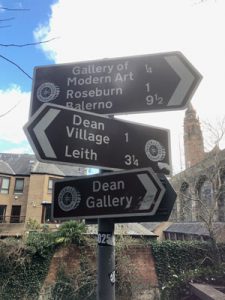
You could be forgiven for thinking this was once some grand stately home but the Dean Gallery was once the Dean Orphanage which was built in 1831 to replace an Orphan Hospital that once stood at the east end of Princes Street. The Dean gallery has an impressive collection of Dada and Surrealist work as well as the work of Leith born artist Eduardo Paolozzi. This gallery also host temporary exhibitions. in the grounds of the gallery there is a small allotment which has been here since the 1940s when wartime necessity saw similar allotments in many schools across the country.
After visiting the Dean Gallery take the main exit onto Belford Road where you will find the Scottish National Gallery of Modern Art across the road. Just as grand as the Dean Gallery this building was also once a school for the education of ‘Fatherless Children’ and was know as George Watson’s School until it began conversion to a gallery in 1981. Again this gallery has both a permanent collection and a programme of changing exhibitions. Among the permanent works are an excellent collection of cubist art, works by Picasso and Matisse and post war British art. The grounds at the front of the gallery also feature a very impressive earthwork and water feature by Charles Jenks. The gallery has a good restaurant / cafe so is an ideal point to take a well earned break before making the return journey.
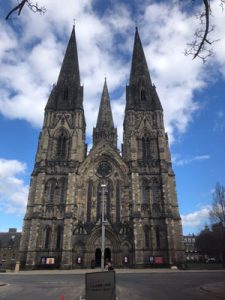
Exit the gallery by the main entrance and turn right, following the road as it first bends left, passing the entrance to the Dean Gallery you used earlier which then bends right into Douglas Gardens and then Palmerston Place. keep going until you reach the large gothic facade of St Mary’s Cathedral a grand structure that is one of Scotland’s Episcopalian cathedrals and dominates the skyline on this side of the city. Take a wander in if you have time and then go through the grounds of the cathedral heading east to the rear of the building. Cross over and take the long straight and wide street called Melville Street to the far end. This street contains a number of embassies and you can spot the flags as you progress along. At the end of this road cross over then go immediately left and then right to enter Randolph Crescent a half circular street with gardens on the left, go halfway round (so a quarter of the circle) and take the first road off till you reach the next small roundabout. This part of the new town features a string of large grand crescents that curve on either side of ornate gardens. From the air the design looks like a crop circle. These were later extensions to the New Town plan, built on an estate owned by the Earl of Moray that sat just to the south of the Water of Leith and Dean Gorge. The buildings here are possibly the most impressive of the New Town townhouses. Explore if you have time or keep taking right turns – along Ainslie Place and up Glenfinlass Street to Charlotte Square.
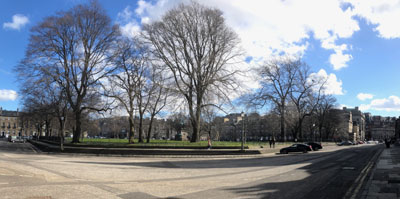
Charlotte Square stands at the opposite end to St Andrews Square where you passed through earlier in the day. The Georgian House on the north side of the square is kept as a museum and a preserved example of what these houses would have been like the their heyday. Keep going south until you hit the busy junction of Shandwick Place, Lothian Road and Princes St. Cross over safely to the south side of Princes St and carry along past the church entrance until you reach the gates of Princes St Gardens, the first gate is for the churchyard, the next of for public toilets so its the third entrance you need. Take the stairs down to the plaza and children’s play area.
This is a good viewpoint for photos of the castle and Ross fountain. currently being renovated the fountain was a gift to the city by Daniel Ross a gunmaker who purchased the fountain from the Great Exhibition of 1862. Head east through the lower level of the gardens until you reach the bandstand, take a right here and go behind the bandstand and over a small footbridge that crosses the railway line. Look left as you go over to see how the railway passes right under the Art gallery you began your journey at. From this angle the gallery appears to be perched on a bridge.
The South side of Princes St Gardens lie on a steep slope under the castle, they are wilder and less well kept than the formal gardens on the north side but have a great charm to them. always a lot less busy than the other side a network of paths will take you all the way up to the castle if you have the stamina or you can keep a sensible elevation as you progress east. More impressive city views open up the further you go. At the end of the gardens a gate will take you on to the mound. Depending where you exited you might have to go up or down but on the other side of the street there is a statue of a highland soldier. just to the left of this there is an entrance that takes you down a steep set of steps that will lead you back to your starting point at the Mound.
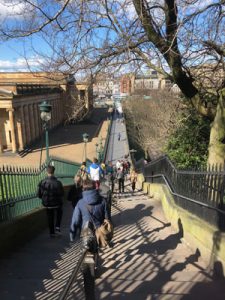
The total route is about 7.75 km or a little under 5 miles. there are a few steep sections but nothing too strenuous. We hope you will have fun tracing following this route through some of the beautiful but slightly less trodden parts of the city.
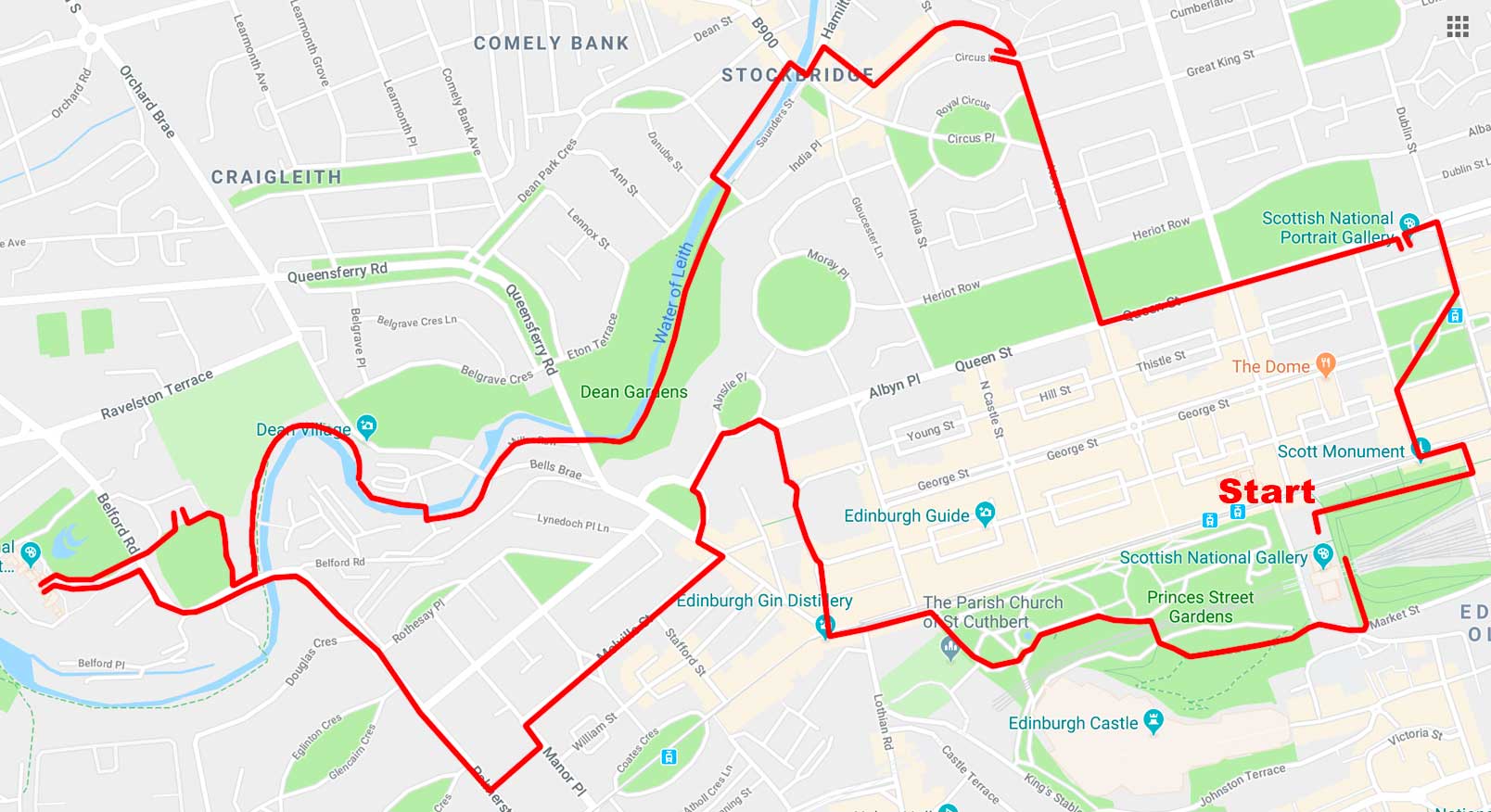
To see the Flikr album of photos from the walk click here
Rodger Moffet

Your walking tours are great!! I am just starting to plan out a trip to Scotland for the latter part of August (but am leaving Edinburgh to the first part of September when the big crowds have left!), and although this will be my 4th visit, it will be great to follow your paths and learn more about Edinburgh as I walk around. I now have both printed off and will study them before coming over. Ever consider doing one, or two, of these in Glasgow as well?? Although I know of most of the main attractions in both cities from research, you are pointing out things you don’t find in travel books! Nice to get such a personal touch.
I love getting your newsletters and have ordered “stuff” from you in the past and plan on doing so in the future as well.
Sincerely,
Madeline Macaulay
London, Ontario, Canada
Thanks – the tours are great fun to do and these have been two very obvious ones. The next two we are thinking about (still in Edinburgh) would be one thats more nature focussed; perhaps starting at Holyrood park and then taking in the Botanics and more of the river (might involve a small bus trip to connect the dots) Also doing one here in Leith as there are lots of very interesting things to see down here.
I loved in Glasgow for a few years so reasonably familiar with it – its a lot more spread out than Edinburgh but ill certainly have a think about a good route that takes in some of the history of the city.